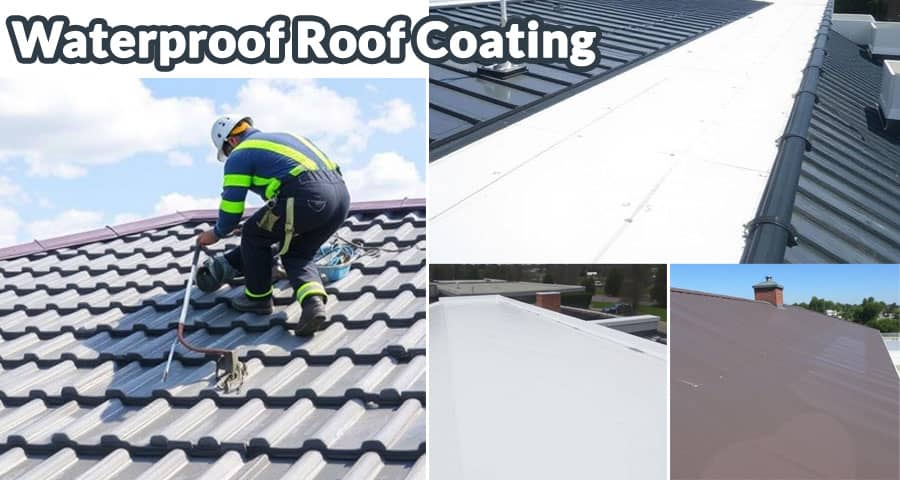What is Waterproof Roof Coating, and How Does It Work?

Waterproof roof coating is a protective layer applied to rooftops to seal, protect, and extend the life of roofing systems. Designed to form a seamless membrane over the surface, these coatings provide a barrier against water intrusion, UV rays, and environmental wear. Applied as a liquid, the coating cures into a durable, flexible shield that adheres tightly to roofing materials, preventing leaks and damage caused by moisture and harsh weather conditions.
Key Benefits of Waterproof Roof Coatings
Enhanced Water Resistance
The primary function of roof coating is to prevent water penetration. By forming an impermeable layer, it keeps rainwater from seeping through cracks, joints, and seams, thus protecting internal structures from water damage.
Extended Roof Lifespan
Waterproof coatings can extend the life of existing roofs by 10 - 20 years or more. They reduce wear and tear, limit exposure to harmful elements, and minimize the need for costly roof replacements.
Energy Efficiency and UV Protection
Most coatings are designed with reflective properties that deflect UV rays. This helps regulate indoor temperature, reduces HVAC loads, and significantly cuts down on energy consumption.
Cost-Effectiveness
Instead of a full roof tear-off, applying a coating is a cost-efficient alternative that saves both time and money. Maintenance and re-coating are also less invasive and more affordable than traditional roof repair methods.
Sustainability and Eco-Friendly Options
Many coatings are formulated with low-VOC materials, making them a greener solution for commercial and residential applications. By avoiding full roof replacements, waste is minimized, contributing to environmental conservation.
How Waterproof Roof Coating Works
Surface Preparation
Before application, the roof surface must be thoroughly cleaned and prepared. This includes removing debris, rust, algae, and loose material. Surface preparation ensures maximum adhesion and performance of the coating. Any cracks, holes, or structural issues should be addressed prior to coating.
Primer Application (If Required)
Certain roof materials like metal or concrete may require a primer layer to promote adhesion. Primers also seal porous surfaces and help prevent coating delamination.
Application of the Waterproof Coating
The coating is applied using rollers, brushes, or spray equipment, depending on the roof size and coating type. Once applied, the liquid coating self-levels and cures into a seamless, rubber-like membrane that resists water infiltration.
Curing and Final Inspection
Curing times vary based on the product and environmental conditions but typically range from 24 to 72 hours. A thorough inspection is conducted post-curing to ensure uniform coverage and proper sealing across all areas, including flashing, joints, and penetrations.
Types of Waterproof Roof Coatings
Acrylic Roof Coatings
Acrylic coatings are water-based, cost-effective, and easy to apply. They are known for their UV resistance and reflectivity, making them ideal for sunny climates. However, they may not perform well in ponding water situations.
Silicone Roof Coatings
Silicone coatings are extremely durable and waterproof, even under ponding conditions. They offer excellent UV stability and weather resistance, making them suitable for challenging climates. Their elasticity allows them to expand and contract with the roof without cracking.
Polyurethane Roof Coatings
These coatings provide superior strength and abrasion resistance. Available in aliphatic and aromatic types, polyurethane coatings are perfect for high-traffic roof areas and environments where durability is a top priority.
Bituminous Roof Coatings
Bitumen-based coatings are commonly used on asphalt and built-up roofs. These coatings provide excellent waterproofing and adhesive properties, especially in colder climates.
Elastomeric Roof Coatings
Elastomeric coatings are flexible, rubber-like membranes that provide seamless waterproofing. They are highly resistant to extreme temperatures and UV radiation, offering long-term performance and energy savings.
Factors to Consider When Choosing a Roof Coating
Roof Material Compatibility
Not all coatings are suitable for every roofing substrate. It's important to match the coating type to the roof material - whether it's metal, asphalt, EPDM, TPO, or concrete.
Climate Conditions
In regions with frequent rainfall, silicone coatings are preferable due to their resistance to ponding water. In hot, sunny areas, acrylic coatings with high solar reflectance are ideal.
Application Method and Labor
Some coatings require professional application with specialized tools. Others can be DIY-friendly, depending on complexity and manufacturer instructions.
Cost and Longevity
Budget plays a critical role. While some coatings are more expensive upfront, they may provide longer protection and reduce maintenance costs in the long term.
Maintenance and Reapplication
A properly applied waterproof coating can last for a decade or longer, but regular maintenance is key. Roofs should be inspected annually for signs of wear, damage, or buildup. When the coating begins to deteriorate or thin out, re-coating is recommended to maintain waterproof performance.
Common Issues and Troubleshooting
- Blistering or Bubbling: Often due to trapped moisture or poor surface preparation. Always ensure surfaces are clean and dry before application.
- Cracking or Peeling: Usually caused by UV degradation or applying the coating in suboptimal conditions. Use coatings rated for your climate and follow curing times precisely.
- Delamination: If the coating separates from the roof surface, it's typically due to incompatibility or missing primer. Always test a small area before full application.
Why Invest in Waterproof Roof Coating?
Investing in a waterproof roof coating means more than just leak prevention - it's a strategic move to preserve your property value, enhance energy performance, and reduce maintenance costs. For commercial buildings and residential homes alike, this added layer of protection ensures long-term durability and peace of mind.
Conclusion
Waterproof roof coating is a cost-effective, energy-efficient, and environmentally friendly solution for extending the life of your roofing system. With the right product, professional application, and routine maintenance, it offers unbeatable protection against the elements while lowering operational costs and avoiding expensive roof replacements.
Please watch the following short video for Waterproof Roof Coating
